Nova Cassiopeiae 2021 (V1405 Cas) has been gradually rebrightening! It was back up to magnitude 7.6 on April 29th, matching the luster it wore just after its March 18th discovery. The dimmest it reached was about magnitude 8.2 through early April.
But the nova has sunk low in the north after nightfall. So catch it when it's high in the northeast before the start of dawn. For charts see Bright Nova Erupts in Cassiopeia.
Comet ATLAS (C/2020 R4) continues at about 9th magnitude. It's now passing between Canes Venatici and Coma Berenices conveniently high in the dark evening sky, now that the waning Moon rises late. You may need a 6-inch scope. See Make the Most of Comet ATLAS.
FRIDAY, APRIL 30
■ Have you gone out to greet Mercury and Venus after sunset yet? They're still quite low in the west-northwest in bright twilight as shown below, Venus especially. So bring binoculars. They're getting a little easier every day.
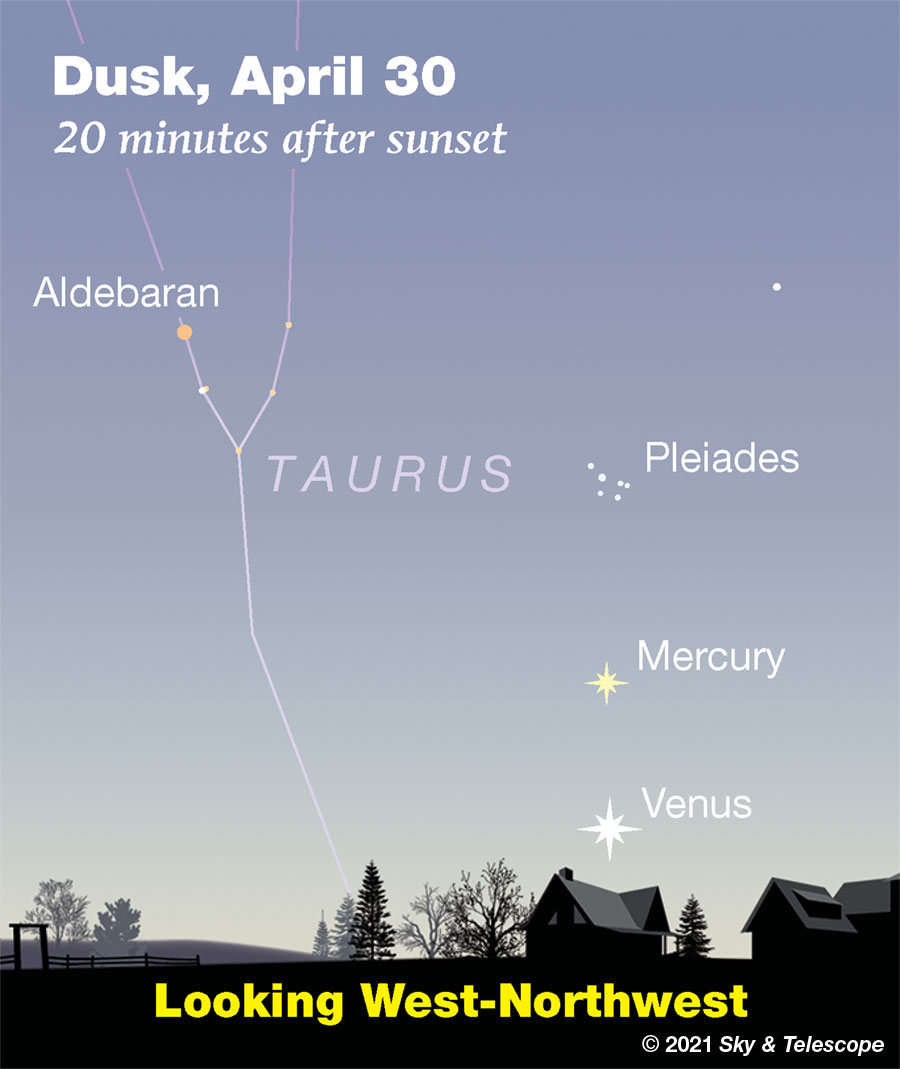
■ As night descends, look high in the west for Pollux and Castor lined up almost horizontally (depending on your latitude). They form the top of the enormous Arch of Spring. To their lower left is Procyon, the left end of the Arch. Farther to their lower right is the other end, formed by Menkalinan (Beta Aurigae) and then brilliant Capella.
This spring the Arch has an intruder: little Mars. It's now about halfway from Procyon to Capella.
■ On the other side of the sky, Arcturus is the brightest star high in the east. Spica shines lower right of it by about three fists at arm's length. To the right of Spica by half that distance is the distinctive four-star constellation of Corvus, the springtime Crow, emerging into view as night deepens.
SATURDAY, MAY 1
■ Although May has begun, wintry Sirius still twinkles very low in the west-southwest in twilight. It sets soon after. How much longer into the spring can you keep Sirius in view? In other words, what will be its date of "heliacal setting" as seen by you? The farther north you are, the sooner Sirius will be gone for the season.
SUNDAY, MAY 2
■ In the early dawn of Monday morning May 3, spot Saturn with the almost last-quarter Moon as shown below. Jupiter looks on from their left.
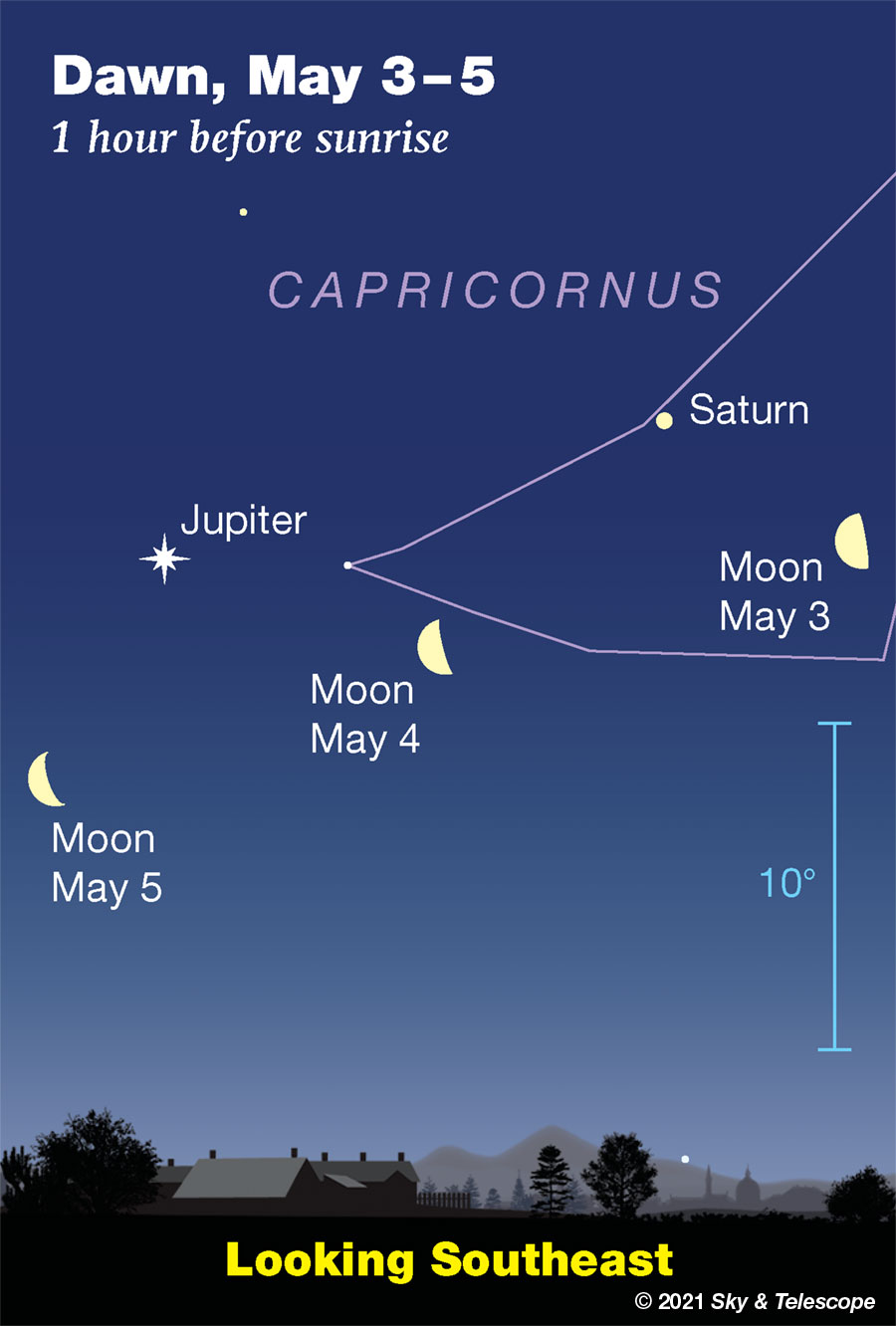
MONDAY, MAY 3
■ Last-quarter Moon (exact at 3:50 p.m. EDT). The Moon rises very late tonight: around 3 a.m. daylight-saving time Tuesday morning May 4th. Once the Moon is up, it's now Jupiter's turn to shine to the Moon's left — with dimmer Saturn looking on from their upper right.
By the time dawn of the 4th begins they're all higher, as shown above.
TUESDAY, MAY 4
■ These spring evenings, the long, dim sea serpent Hydra snakes almost level far across the southern sky.
Find his head, a rather dim asterism about the width of your thumb at arm's length, in the west-southwest. It's lower right of Regulus by about two fists at arm's length. (Also, a line from Castor through Pollux points to it about 2½ fists from them.)
Hydra's brightest star, 2nd-magnitude Alphard, glows as his orange heart less than two fists left of the head. Hydra's tail stretches all the way to Libra rising in the southeast. Hydra's star pattern, from forehead to tail-tip, is 95° long.
WEDNESDAY, MAY 5
■ The Big Dipper now floats level upside down right after dark, when you face north-northeast and look very high. Its handle is on the right. Its Pointer stars, forming the left end of the Dipper's bowl, point down toward Polaris.
■ The Eta Aquariid meteor shower is often the year's best for the Southern Hemisphere, but few Eta Aquariids are ever in view from mid-northern latitudes. If you want to try, the best time is Thursday morning for the hour before the first light of dawn. (Start watching 2½ hours before your local sunrise time.) A thick waning crescent Moon will be in the sky.
THURSDAY, MAY 6
■ The grand galaxies M81 and M82 are among the most-sought telescopic targets when the bowl of the Big Dipper is high. But have you ever tried for the two lesser galaxies in their vicinity, and the four double stars here for amateur scopes? Two of those are easy to resolve; two are challenging. See Ken Hewitt-White's Suburban Stargazer column in the May Sky & Telescope, page 54.
FRIDAY, MAY 7
■ Mercury is now easily spotted in twilight if you have a good view to the west-northwest. But Venus, despite its brightness, can still be tricky 8° below. The visibility of points in bright twilight is exaggerated here:
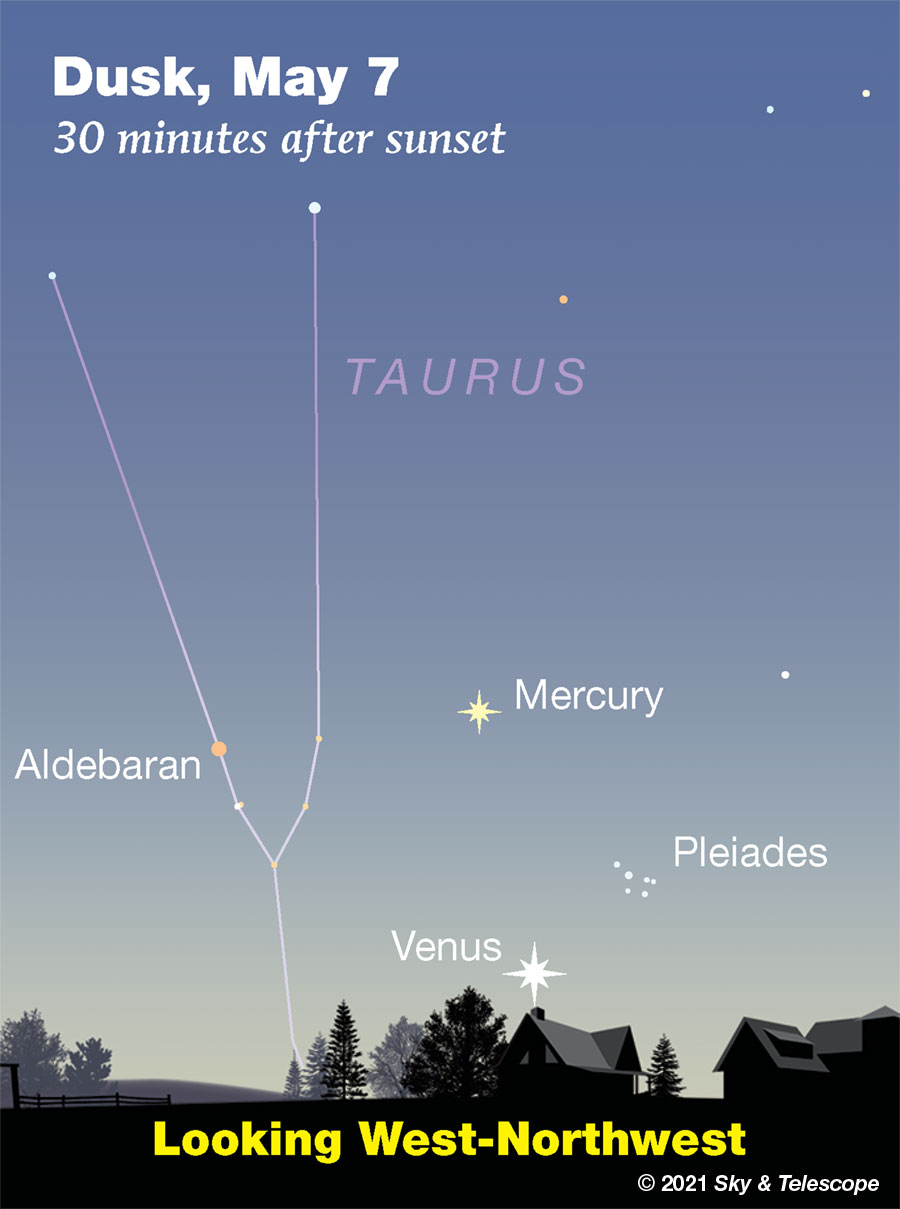
■ Higher in the west as night falls, little Mars is approaching the base of the Arch of Spring: the long line from Procyon on the left to Capella on the right. Mars will stand exactly on this line next Tuesday May 11th. You can watch its daily progress toward and across this line more precisely by holding a yardstick or other straightedge to the sky from Procyon to Capella, or by stretching a string tightly from one star to the other between your hands.
Beware of the tricky illusion that a line in the sky that's parallel to the horizon will be a straight line. Nope! The horizon is indeed a great circle around the celestial sphere; so it's straight for a viewer at the center of the sphere, meaning you. But a circle drawn around the sky at some constant altitude above the horizon will be a small circle, not centered on you, so its rim will appear bent. Severely so across a large span of sky.
Many people cannot believe that this would be true. That's why to bring the straightedge or piece of string, rather than trying to judge a straight line from Procyon to Capella by eye — with the horizon enticing you to make it a reference. Prove it to yourself!
■ Summer is still seven weeks away, but the Summer Triangle is beginning to make its appearance in the east, one star after another. The first in view is bright Vega. It's already visible low in the northeast as twilight fades.
Next up is Deneb, lower left of Vega by a little more than two fists at arm's length. Deneb takes about an hour to appear after Vega does, depending on your latitude.
The third corner of the triangle is Altair, which shows up far to their lower right by midnight.
SATURDAY, MAY 8
■ A gigantic asterism you may not know about is the Diamond of Virgo, some 50° tall and extending over five constellations. It now stands upright in the south after the stars come out. Start with Spica, its bottom. Upper left from Spica is bright Arcturus. Almost as far upper right from Arcturus is fainter Cor Caroli, 3rd magnitude. The same distance lower right from there is Denebola, the 2nd-magnitude tailtip of Leo. And then back to Spica.
The bottom three of these stars, the brightest, form a nearly perfect equilateral triangle. So maybe we should call Arcturus, Spica and Denebola the "Spring Triangle" to parallel those of summer and winter?
In you have a dark sky, or binoculars, look halfway from Cor Caroli to Denebola for the very large, sparse Coma Berenices star cluster. It spans some 4°, about the size of a ping-pong ball held at arm's length.
This Week's Planet Roundup
Mercury and Venus are emerging from deep in the sunset day by day. Mercury is highest, as shown in the scenes above, and coming into an excellent evening apparition.
Look early for Venus far below it; Venus sets before twilight is even half over. Venus shines at magnitude –3.9 all week. Mercury, by contrast, fades this week by almost half: from magnitude –1.1 to –0.5.
Mars (magnitude +1.6, in Gemini at the feel of the Castor figure) glows in the west right after dark. It's a about midway between brighter Procyon and Capella. In a telescope it's a mere 4.6 arcseconds wide: just a tiny bright blob.
Jupiter and Saturn (at dim Capricornus) rise more than an hour before the first light of dawn. As dawn begins, spot them in the southeast. Jupiter grabs the eye at magnitude –2.2. Saturn, 16° to Jupiter's right or upper right, is one fifteenth as bright at magnitude +0.7.
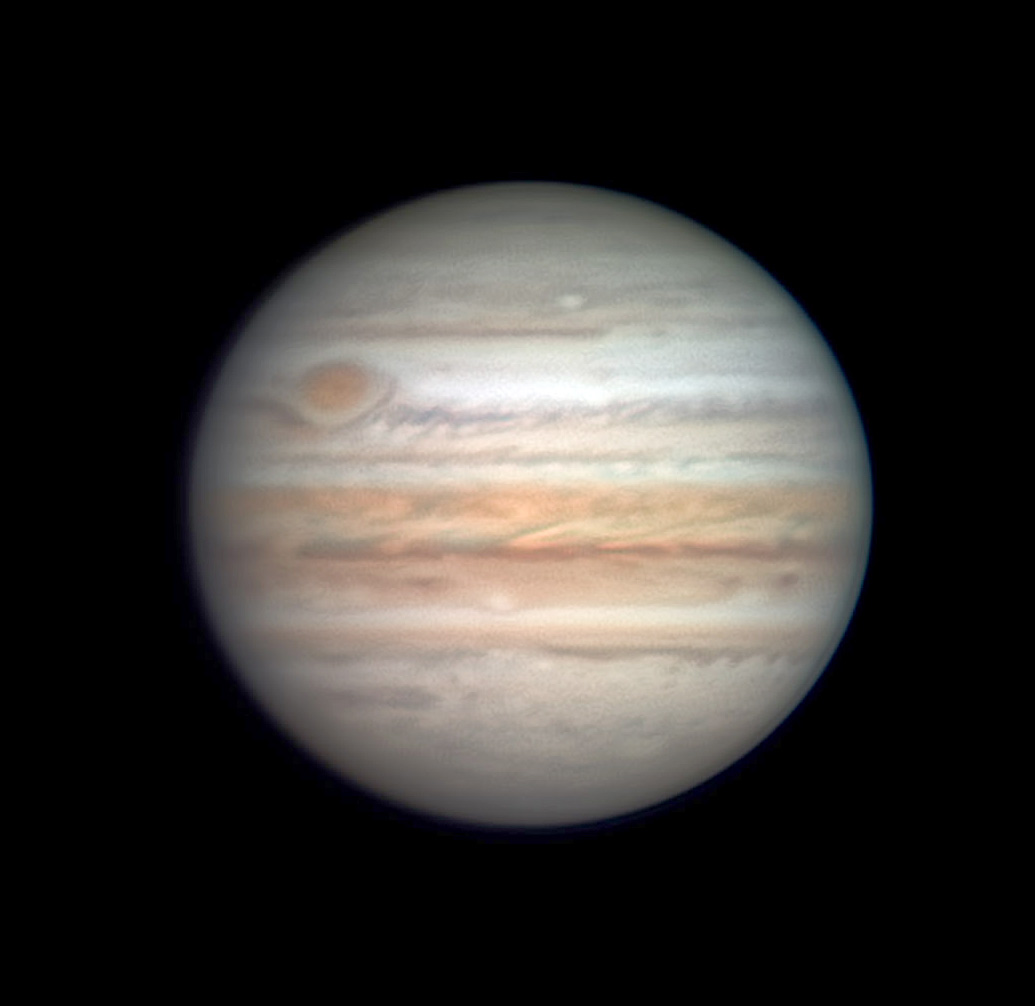
The South Equatorial Belt following (right of) the Red Spot is unusually pale. The Equatorial Zone continues to show complex tan patterns across its northern two-thirds, and the south edge of the North Equatorial Belt is dark red.
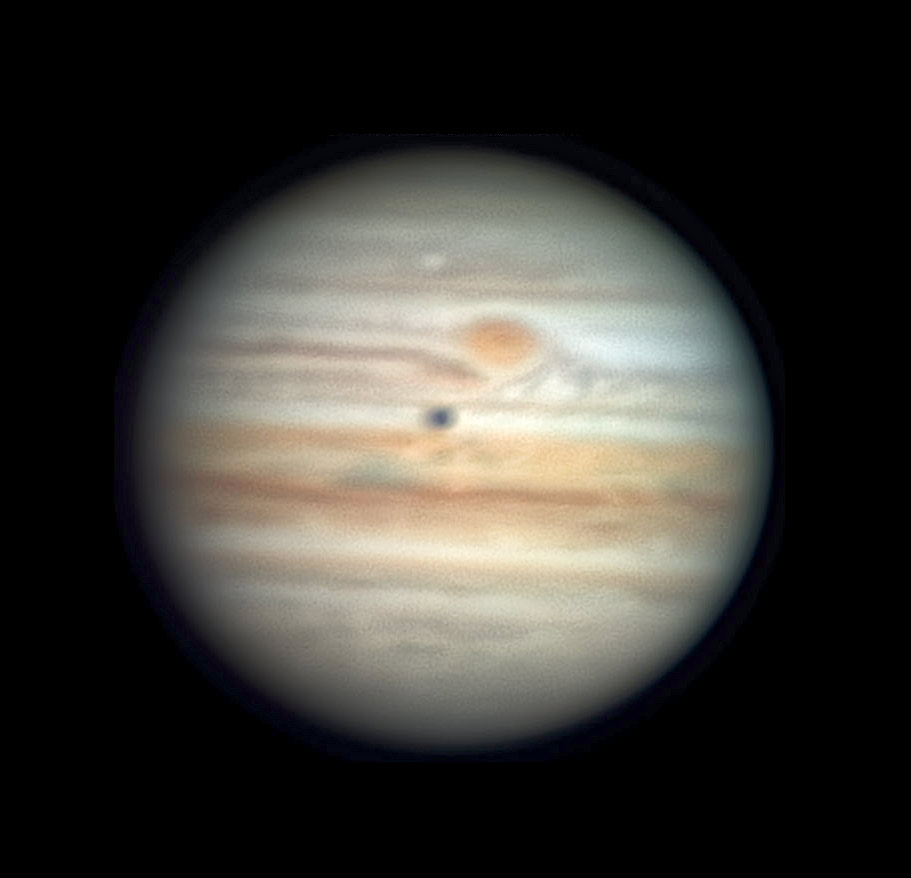
Uranus and Neptune are hidden in the glare of the Sun.
All descriptions that relate to your horizon — including the words up, down, right, and left — are written for the world's mid-northern latitudes. Descriptions that also depend on longitude (mainly Moon positions) are for North America.
Eastern Daylight Time, EDT, is Universal Time minus 4 hours. Universal Time is also known as UT, UTC, GMT, or Z time. To become more expert about time systems than 99% of the people you'll ever meet, see our compact article Time and the Amateur Astronomer.
Want to become a better astronomer? Learn your way around the constellations. They're the key to locating everything fainter and deeper to hunt with binoculars or a telescope.
This is an outdoor nature hobby. For an easy-to-use constellation guide covering the whole evening sky, use the big monthly map in the center of each issue of Sky & Telescope, the essential magazine of astronomy.
Once you get a telescope, to put it to good use you'll need a detailed, large-scale sky atlas (set of charts). The basic standard is the Pocket Sky Atlas (in either the original or Jumbo Edition), which shows stars to magnitude 7.6.

Next up is the larger and deeper Sky Atlas 2000.0, plotting stars to magnitude 8.5; nearly three times as many. The next up, once you know your way around, are the even larger Interstellarum atlas (stars to magnitude 9.5) or Uranometria 2000.0 (stars to magnitude 9.75). And be sure to read how to use sky charts with a telescope.
You'll also want a good deep-sky guidebook, such as Sky Atlas 2000.0 Companion by Strong and Sinnott, or the bigger (and illustrated) Night Sky Observer's Guide by Kepple and Sanner.
Can a computerized telescope replace charts? Not for beginners, I don't think, and not on mounts and tripods that are less than top-quality mechanically, meaning heavy and expensive. And as Terence Dickinson and Alan Dyer say in their Backyard Astronomer's Guide, "A full appreciation of the universe cannot come without developing the skills to find things in the sky and understanding how the sky works. This knowledge comes only by spending time under the stars with star maps in hand."
![]() Audio sky tour. Out under the evening sky with your
Audio sky tour. Out under the evening sky with your
earbuds in place, listen to Kelly Beatty's monthly
podcast tour of the heavens above. It's free.
"The dangers of not thinking clearly are much greater now than ever before. It's not that there's something new in our way of thinking, it's that credulous and confused thinking can be much more lethal in ways it was never before."
— Carl Sagan, 1996
"Facts are stubborn things."
— John Adams, 1770
 4
4









Comments
Rod
May 2, 2021 at 8:03 am
A great evening out under the stars last night. Observed 1930-0030 EDT 01-May 02-May. Sunset 1959 EDT. Last Quarter Moon 03-May-2021 1950 UT. A delightful cool spring evening viewing globular clusters and various galaxies using my 10-inch and 2-inch, low power eyepiece. Magnification tonight at 34x with 1.8-degree true FOV. Owls were hooting in the woods; some deer were moving around in the woods while I was out. Cool spring evening with temperature 10C. Low power sweep through Virgo showed an area with many faint galaxy targets including M86 and M87 as I moved between Virgo and Leo, the Virgo Cluster. M51 galaxy a nice view, both components visible but nothing real distinct. M51 takes higher power views to see more detail in the two components. M13 became visible above the trees near midnight because of my location in the pasture. M5 was a nice view too. However, the globular clusters to see many stars resolved in the outer regions need higher power views, I was scanning and enjoying 34x views tonight using the 2-inch eyepiece. M13 and M5 are nice and bright in the eyepiece with various faint stars all around the FOV. By 2050 EDT, I was able to view M65, M66, and NGC 3628, the Leo trio and then observed M44 and M67 in Cancer. Both open clusters provided excellent views. M95, M96, and M105 easy targets too in Leo. This was a great evening under the stars tonight and I could see 7 stars in Coronae Borealis distinctly along with some mv +5.5 stars too. Earlier 4 satellites moved by in polar orbits, some could be Starlink, they were 4th-5th magnitude I estimate. Arcturus and sky area, busy for some of these satellites tonight passing overhead near and after 2100 EDT. After sunset, Capella was the first star I noticed using unaided eyes. I adjusted the Telrad using Capella, Mars, Aldebaran, and Procyon to center objects in the eyepiece and finder scope views. I could see Polaris and as the evening progressed, Ursa Major and other circumpolar stars changed their sky position relative to Polaris. Other constellations ascended in the East and continued slow movement towards the West, e.g., Arcturus, Coronae Borealis, and Hercules with M13. I enjoyed M13 at 34x using the telescope, watching it ascend above the trees nearby my location and clear the top branches, coming out into the open sky while Polaris is steady. This was cool seeing Earth rotation like this. No cameras or imaging of star trails needed. I enjoyed clear skies, a good view of Polaris for 5 hours and observing the constellations change their positions.
You must be logged in to post a comment.
mary beth
May 4, 2021 at 1:14 am
Hello Rod! This is the best report! I love all the details and it sounds like you had a perfect start to May! Wonderful you saw all seven stars in the Coronae Borealis. One year ...maybe 2006 or 2007, I felt like it was extra bright... probably just my imagination but I felt like I could see five stars unaided. Now I have trouble finding it!
One clear night this summer I might try to observe the earth’s rotation like you did.It’s one thing to see the stars in a different spot from night to night, but to watch the constellations move around Polaris during one night would be a very worthwhile project.
Clouds tonight but we are getting a little cold front tomorrow (my birthday!) so we should have clear skies the rest of the week. Trying to make a point to see Aldebaran before it disappears. We usually have some bats for company right at civil twilight. There’s also a Heron that flies around the neighborhood.
Hope you have good weather as well!
You must be logged in to post a comment.
Rod
May 6, 2021 at 6:48 am
I did enjoy viewing some Eta Aquarids this morning along with Jupiter, Saturn, and rising waning crescent Moon. Here is a link with my report note. https://skyandtelescope.org/observing/sky-tour-podcast-may-2021/#comment-304652
You must be logged in to post a comment.
mary beth
May 6, 2021 at 8:02 pm
I read your report and it sounds like you had a very interesting and eventful morning! thank you for sharing and writing up a great report.
You must be logged in to post a comment.
You must be logged in to post a comment.